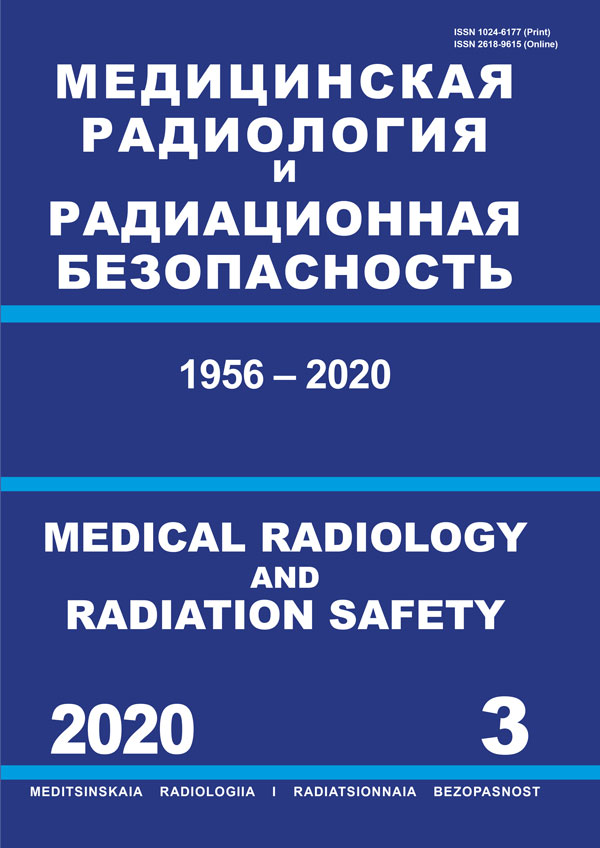Russian Federation
Russian Federation
CSCSTI 76.03
CSCSTI 76.33
Russian Classification of Professions by Education 14.04.02
Russian Classification of Professions by Education 31.06.2001
Russian Classification of Professions by Education 31.08.08
Russian Classification of Professions by Education 32.08.12
Russian Library and Bibliographic Classification 51
Russian Library and Bibliographic Classification 534
Russian Trade and Bibliographic Classification 5708
Russian Trade and Bibliographic Classification 5712
Russian Trade and Bibliographic Classification 5734
Russian Trade and Bibliographic Classification 6212
Purpose: Search of possible criteria of the diagnosis of occupational lung cancer in workers of uranium mines on the basis of the analysis of literary data. Material and methods: The analysis of literary data with the purpose of allocation of possible criteria and their use for the diagnosis of occupational lung cancer at 6 employees of uranium mines. Results: The following criteria for the diagnosis of occupationally caused lung cancer at workers of uranium mines are marked out: • Total effective dose of radiation exposure is more 200–250 mSv (40–50 WLM). • Period in underground conditions is not less than 10 years. • Dust content in a workplace is more than 1 mg/m3. • Hygienic assessment of working conditions – the 3rd class, 3.2–3.4 degree. • The latent period of development of a tumor is not less 10 years. • Development of primary and multiple synchronous or metachronous lung cancer. Also the diagnosis of occupational lung cancer the pulmonary anamnesis (frequent bronchitis, pneumonia, chronic bronchitis of the smoker) has to be considered. On the basis of the marked-out criteria documents of 6 employees of uranium mines, at which lung cancer has been revealed, are considered. On the basis of the carried-out analysis at 5 patients relation of a disease with professional activity has been established. One patient was denied this relation. Conclusion: Authors offer this expert approach to experts’ discussion as above-mentioned criteria is planned to be used by the pathologists who are carrying out observation of workers of uranium production and for the solution of questions of relation of a disease with professional activity of the patient.
newborns, asphyxia of severe degree, general therapeutic hypothermia, radiation monitoring
1. Medico-Demographic Indicators of the Russian Federation in 2014. Moscow. 2015. 186 p. (Russian).
2. Baranov AA, Ilyin AG, Konova SR, Antonova EV. Ways to improve the quality and accessibility of medical care for children in primary care. Questions of Modern Pediatrics. 2009;4(8):5-8. (Russian).
3. Jacobs SE, Morley CJ, Inder TE, et al. Infant Cooling Evaluation Collaboration. Whole-body hypothermia for term and near-term newborns with hypoxic-ischemic encephalopathy: a randomized controlled trial. Arch Pediatr Adolesc Med. 2011;165(8):692-700.
4. TOBY Protocol and Handbook. 2009. Available at: https: www.npeu.ox.ac.uk./tobyregister/docs. (accessed 25 October 2015).
5. Robertson NJ, Nakakeeto M, Hagmann C, et al. Therapeutic hypothermia for birth asphyxia in low-resource settings: a pilot randomised controlled trial. Lancet. 2008;372(9641):801-3.
6. Shah P, Riphagen S, Beyene J, Perlman M. Multiorgan dysfunction in infants with post-asphyxial hypoxic-ishaemic encephalopathy. Arch Dis Child Fetal Neonatal Ed. 2004;89:152-5.
7. Ionov OV. The protocol of medical hypothermia of children born in asphyxia. Neonatology. 2014;2:43-5. (Russian).
8. Edwards AD, Brocklehurst P, Gunn AJ, et al. Neurological outcomes at 18 months of age after moderate hypothermia for perinatal hypoxic ischemic encephalopathy: synthesis and meta-analysis of trial data. BMJ. 2010;9:340-63.
9. Grigoryev EV, Shukevich DL, Plotnikov GP, Tikhonov NS. Therapeutic hypothermia: possibilities and prospects. Clinical Medicine. 2014; 9: 9-16. (Russian).





